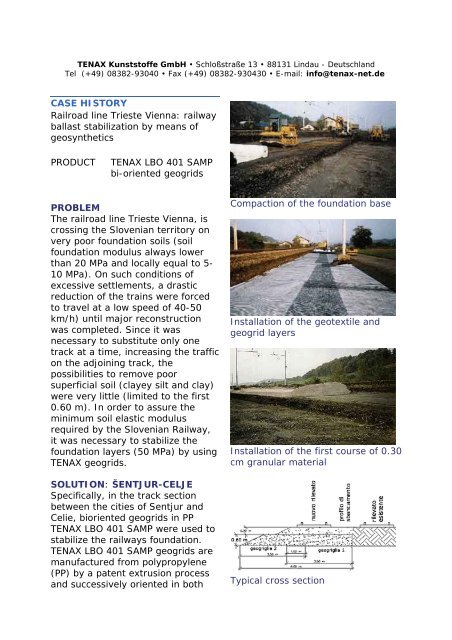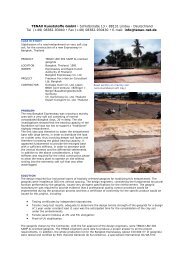TENAX Kunststoffe GmbH - extrudierte Netze und Gitter aus Kunststoff
TENAX Kunststoffe GmbH - extrudierte Netze und Gitter aus Kunststoff
TENAX Kunststoffe GmbH - extrudierte Netze und Gitter aus Kunststoff
You also want an ePaper? Increase the reach of your titles
YUMPU automatically turns print PDFs into web optimized ePapers that Google loves.
<strong>TENAX</strong> <strong><strong>Kunststoff</strong>e</strong> <strong>GmbH</strong> • Schloßstraße 13 • 88131 Lindau - Deutschland<br />
Tel (+49) 08382-93040 • Fax (+49) 08382-930430 • E-mail: info@tenax-net.de<br />
CASE HISTORY<br />
Railroad line Trieste Vienna: railway<br />
ballast stabilization by means of<br />
geosynthetics<br />
PRODUCT<br />
<strong>TENAX</strong> LBO 401 SAMP<br />
bi-oriented geogrids<br />
PROBLEM<br />
The railroad line Trieste Vienna, is<br />
crossing the Slovenian territory on<br />
very poor fo<strong>und</strong>ation soils (soil<br />
fo<strong>und</strong>ation modulus always lower<br />
than 20 MPa and locally equal to 5-<br />
10 MPa). On such conditions of<br />
excessive settlements, a drastic<br />
reduction of the trains were forced<br />
to travel at a low speed of 40-50<br />
km/h) until major reconstruction<br />
was completed. Since it was<br />
necessary to substitute only one<br />
track at a time, increasing the traffic<br />
on the adjoining track, the<br />
possibilities to remove poor<br />
superficial soil (clayey silt and clay)<br />
were very little (limited to the first<br />
0.60 m). In order to assure the<br />
minimum soil elastic modulus<br />
required by the Slovenian Railway,<br />
it was necessary to stabilize the<br />
fo<strong>und</strong>ation layers (50 MPa) by using<br />
<strong>TENAX</strong> geogrids.<br />
SOLUTION: ŠENTJUR-CELJE<br />
Specifically, in the track section<br />
between the cities of Sentjur and<br />
Celie, bioriented geogrids in PP<br />
<strong>TENAX</strong> LBO 401 SAMP were used to<br />
stabilize the railways fo<strong>und</strong>ation.<br />
<strong>TENAX</strong> LBO 401 SAMP geogrids are<br />
manufactured from polypropylene<br />
(PP) by a patent extrusion process<br />
and successively oriented in both<br />
Compaction of the fo<strong>und</strong>ation base<br />
Installation of the geotextile and<br />
geogrid layers<br />
Installation of the first course of 0.30<br />
cm granular material<br />
Typical cross section
MD and TD directions thus creating<br />
biaxial geogrids.<br />
After the removal of the ballast and<br />
partial fo<strong>und</strong>ation soil, the<br />
fo<strong>und</strong>ation was compacted by<br />
means of a compactor roller (photo<br />
n. 1); then a geotextile, a <strong>TENAX</strong><br />
LBO 401 SAMP geogrid (photo n. 2)<br />
and 60 cm layer of granular<br />
material were placed (laid and<br />
compacted in two different lifts)<br />
(photo n. 3) and successively<br />
covered with 30 cm of ballast. A<br />
nonwoven geotextile below the<br />
bioriented geogrid in PP to has been<br />
installed at the base of the ballast.<br />
The geotextile provides the filtering<br />
effects between the fo<strong>und</strong>ation soil<br />
and the ballast, while the geogrid<br />
prevents the geotextile from<br />
excessive deformation and stiffening<br />
the subbase (reinforcement and<br />
separation functions).<br />
In this way the so called risk of<br />
"pumping" of fine particles of the<br />
fo<strong>und</strong>ation inside the granular<br />
material of the ballast, due to the<br />
compression and decompressing<br />
cycles c<strong>aus</strong>ed by the rapid passage<br />
of trains, was avoided.<br />
The grain size variation, due to the<br />
increasing portion of the fine<br />
fraction, generates a progressive<br />
water retention within the ballast,<br />
with consequent greater<br />
settlements. Besides, the separation<br />
layer at the toe of the ballast allows<br />
a filtering action between the ballast<br />
and the fo<strong>und</strong>ation soil, avoiding the<br />
capillary raise from fo<strong>und</strong>ation.<br />
CONCLUSIONS<br />
The embankment was completed in winter of 1996 and the railway line is<br />
fully operative. The geogrids installed were monitored by means of<br />
extensometers to verify the local shear stresses acting on the<br />
reinforcement. The low mobilised geogrid strains show that the geogrid is
fully performing within the reinforced section as a rigid load transfer<br />
platform; thus minimizing the shear displacement and consequent loss of<br />
bearing capacity and settlements.<br />
<strong>TENAX</strong> <strong><strong>Kunststoff</strong>e</strong> <strong>GmbH</strong> • Schloßstraße 13 • 88131 Lindau - Deutschland<br />
Tel (+49) 08382-93040 • Fax (+49) 08382-930430 • E-mail: info@tenax-net.de




